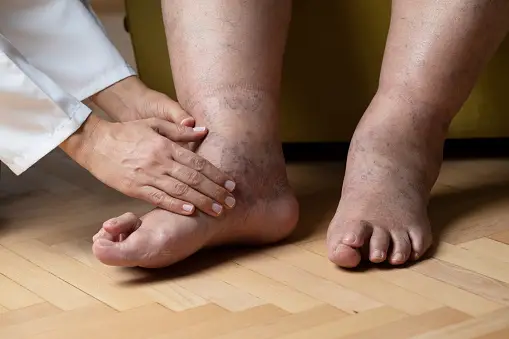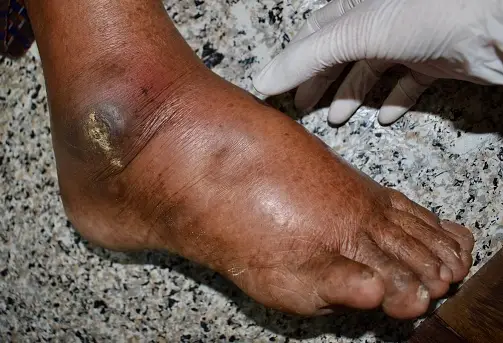First we understand about Edema:
Edema is state of abnormal accumulation of fluid in the differential spaces. It leads to swelling or puffiness in various parts of the body. Edema can affect different area such as ankles, feet, legs, hands and other part of the body. This condition is occurs when there is an imbalance between the movement of fluid in and out of the cells. It results the excess build up of fluids in the tissues.

Different types:
Peripheral edema:
Peripheral edema refers to the swelling of the extremities, such as the legs, feet, ankles, and hands. It occurs when there is an abnormal accumulation of fluid in the interstitial spaces of these peripheral tissues.
Pulmonary edema:
It is a medical condition characterized by the accumulation of fluid in the lungs, specifically in the alveoli and the interstitial spaces within the lung tissue. This accumulation of fluid can impede the normal exchange of oxygen and carbon dioxide, leading to respiratory distress.
Cerebral edema:
This condition occurs due to the accumulation of excess fluid in the brain. This condition can lead to increased pressure within the skull, potentially causing damage to brain tissue and affecting neurological function.
Macular edema:
The macula, which is the central part of the retina responsible for sharp, central vision, experiences swelling and the accumulation of fluid, resulting in macular edema. This swelling can lead to distorted or blurred vision and is a common complication of various eye conditions.
Lymphedema:
The accumulation of lymphatic fluid causes swelling in the case of lymphedema. It commonly occurs in the arms or legs and may result from lymph node removal, damage, or congenital conditions.
Systemic edema:
Systemic edema refers to generalized swelling throughout the body. It can be a symptom of underlying systemic conditions like heart, kidney, or liver diseases.
Cyclic edema:
Some women experience periodic swelling, which is a characteristic of cyclic edema, during specific times such as the menstrual cycle.
Idiopathic edema:
Idiopathic edema is when the cause of fluid retention is unknown. It often occurs in women and may be related to hormonal changes or other factors.
Sites of edema:
When the edema is present in the superficial tissues pitting of the surface may be observed. The sites at which superficial edema is observed may be influenced by gravity and the position of the individual. When the individual is in the standing or sitting position the edema observed in the lower limbs, beginning in the feet and ankles. Patients on bedrest tend to develop edema in the sacral area. This may be described as dependent edema.
In pulmonary edema, venous congestion in the lungs, or increased vessel permeability results in the accumulations of fluid in the tissue spaces and in the alveoli. This reduces the area available for gaseous exchange and results in dyspnoea (breathlessness), cyanosis and expectoration of frothy sputum.

Causes:
Increased venous hydrostatic pressure:
Congestion of the venous circulation increases venous hydrostatic pressure, and can decrease the effect of osmotic pressure that draws fluid back into the capillary at the venous end. Excess fluid remains in the tissues. This may be caused by:
- Heart failure
- Kidney disease
- External pressure on a limb due to prolonged sitting or tight garments.
Decreased plasma osmotic pressure:
When there is a decreased amount of plasma proteins, less fluid returns to the circulation at the venous end of the capillary.
Causes include:
- Acute nephritis when the kidneys excrete protein
- Nephritic syndrome
- Liver failure
- Malnourishment where protein intake in very low
Increased small vessel permeability:
In inflammatory condition, chemical mediators increase small vessel permeability in the affected area. Plasma proteins then leave the circulation and the increased tissue osmotic pressure draws fluid into the area causing swelling of the affected tissue. This type of edema also occurs in allergic reaction. For example: anaphylaxis, asthma, hay fever.
Methods to overcome edema:
Address the underlying cause:
Treatment will often focus on managing the condition causing the edema, such as heart failure, kidney disease, liver disease, or venous insufficiency.
Medications:
Diuretics (water pills) may be prescribed to help the body eliminate excess fluid through urine. However, their use should be carefully monitored by a healthcare professional.
Compression therapy:
Compression stockings or bandages can help reduce swelling by applying pressure to the affected area and promoting the movement of fluid.
Elevating the affected limbs:
Elevating the swollen limb above the level of the heart can aid in reducing fluid buildup.
Dietary changes:
Limiting salt intake may be recommended, as excessive sodium can contribute to fluid retention. A diet rich in fruits, vegetables, and lean proteins is generally beneficial.
Physical activity:
Regular exercise can help to increase circulation and reduce fluid retention. However, it’s important to consult with a healthcare professional or physician before starting any exercise regimen.
Lifestyle modifications:
Avoiding prolonged periods of sitting or standing can help prevent fluid accumulation.
Weight management:
Maintaining a healthy weight can reduce the risk of developing edema, especially in conditions like heart failure and obesity.
Treatment for specific conditions:
In cases where edema is a symptom of a specific condition, such as lymphedema, specific therapies like manual lymphatic drainage may be recommended.
FAQ’s:
Q.1) Is edema a symptom of another medical condition?
Yes, edema is often a symptom of an underlying medical condition, such as heart, kidney, or liver diseases.
Q.2) Can medications cause edema?
Yes, certain medications, including some blood pressure medications, nonsteroidal anti-inflammatory drugs (NSAIDs), and steroids, can cause fluid retention and edema.
Q.3) Can edema be prevented?
Prevention depends on the underlying cause. Lifestyle modifications such as a low-sodium diet, regular exercise, and weight management can help prevent edema in some cases.
Q.4) What are the common signs and symptoms of edema?
Swelling, usually in the extremities (hands, legs, ankles, and feet), and sometimes in the abdomen or face. Other symptoms such as feeling of heaviness or tightness in the affected area.
Q.5) How is edema treated?
Treatment involves addressing the underlying cause. This may include medications (diuretics), compression therapy, lifestyle modifications, and managing the primary medical condition.
Q.6) Are there home remedies for managing edema?
Elevating the affected limbs, limiting salt intake, wearing compression stockings, and regular exercise are some home remedies that may help manage edema. However, please consult with a healthcare professional before you try these approaches.
Q.7)When should I seek medical attention for edema?
It’s important to seek medical attention if you experience sudden or severe swelling, swelling that persists, or if you have additional symptoms such as chest pain, difficulty breathing, or changes in urine output.

Pingback: Natural treatment for edema in legs and feet - Pharmacyinfos
Pingback: Pulmonary hypertension supportive therapy - Pharmacyinfos
Pingback: Ischemic cardiomyopathy treatment - Pharmacyinfos
Pingback: Diuretics Mechanism Of Action - Pharmacyinfos